Europe, British Isles, England, Welsh March, Herefordshire, Wigmore Abbey [Map]
Wigmore Abbey is in Wigmore, Herefordshire [Map].
In 1291 Wigmore Abbey [Map] was recorded as holding lands in Cynham, Snitton, Shobdon, Leintwardine, Presteigne, Aymestrey, Bredwardine, Choulton, Kinlet, Walton, Neen Savage, Westwood, Mambe, Billebure, Ludlow, Colkeshale, La Neuton, Assiston, Clungunford, Burford, Greete, Moeles Brace, Ratlinghope and Wigmore together with the churches of Burley, Aymestrey, Shobdon, Presteigne, Byton, Staunton, Bredwardine, Hopton Wafre, Cleobury Mortimer, Momel, Nene Solars, Limebrook, Chelmarsh, Higley, Kinlet, Neen Savage, Chetton, Moeles Brace, Ledbury, Bucknell, Bishop's Castle, Leintwardine and the chapels of Burrington and Downtown.
Around 1104 Ranulph Mortimer (age 35) died. He was buried at Wigmore Abbey [Map].
In 1127 Hawise Mortimer Countess Aumale died. She was buried at Wigmore Abbey [Map].
In 1127 Stephen Blois Count Aumale (age 57) died. He was buried at Wigmore Abbey [Map]. Earl Holderness Feudal extinct.
Before 1148 Abbot Simon Merlymond was the first Abbot of Wigmore Abbey [Map]. The community moved around Herefordshire, initially at Shobdon, Herefordshire, a number of times following its creation before settling at Wigmore Abbey [Map].
From 1148 to 1155 Andrew of St Victor (age 55) was Abbot of Wigmore Abbey [Map].
From 1162 to 1175 Andrew of St Victor (age 75) was Abbot of Wigmore Abbey [Map].
In 1172 Andrew Staunton fled his Marcher lands with his wife, Matilda Port and claimed sanctuary in Wigmore Abbey [Map] after bribing the abbot with the gift of Bucknell church in Shropshire. Matilda remained in the abbey until after 1174, by which time her husband had fled from the abbey to Scotland and then returned with a Scottish army to attack King Henry II.
Between 1174 and 1179 Hugh Mortimer granted St Mary Magdalene's Church, Leintwardine [Map] to his new foundation of Wigmore Abbey [Map]. The St Mary Magdalene's Church, Leintwardine [Map] is built partly in the vallum, or ditch, that enclosed the Roman town of Bravonium. The foundations are Saxon and Norman but the main part of the church is 13th and 14th century. The earliest detail in the church is the blocked 12th-century W. doorway, which is probably not in situ. Towards the end of the thirteenth century a south aisle was added to the nave and in the first half of the fourteenth century a north aisle and two chapels were added together with a new chancel and an impressive south tower of five storeys over a powerful porch.
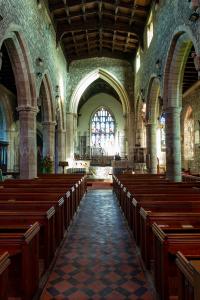
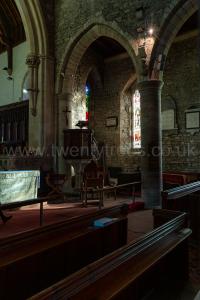
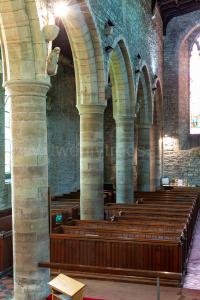
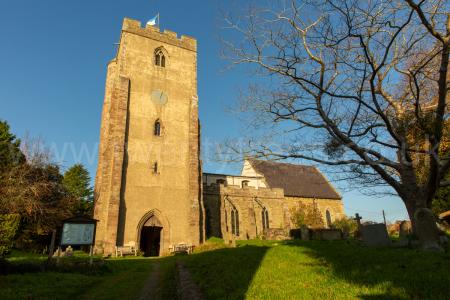
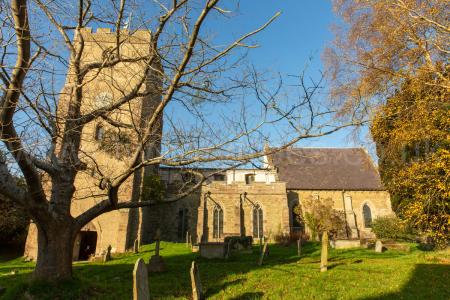
In 1179 Wigmore Abbey [Map] was consecrated by Bishop Gilbert Foliot. It had been founded by Hugh Mortimer (age 79) in 1172 - see Wigmore Chroncle.
On 26 Feb 1181, possibly, the date uncertain, Hugh Mortimer (age 81) died. He was buried at his foundation Wigmore Abbey [Map].
Around 1193 Brian Brampton died. He was buried in the Mortimer Chapel of Wigmore Abbey [Map] of which he was one of the founders.
In 1202 Hugh Mortimer of Chelmarsh (age 48) died. He was buried at Wigmore Abbey [Map].
Before 08 Jul 1214 Roger Mortimer (age 62) died. He was buried at Wigmore Abbey [Map].
In 1227 Hugh Mortimer died in a tournament. He was buried at Wigmore Abbey [Map]; his viscera were buried at Reading Abbey [Map]. His widow Eleanor Braose became a nun at Iffley.

On 06 Aug 1246 Ralph Mortimer (age 56) died. He was probably buried at Wigmore Abbey [Map].
On 30 Oct 1282 Roger Mortimer 1st Baron Mortimer of Wigmore (age 51) died. He was buried at Wigmore Abbey [Map] where the inscription of his tombstone reads "Here lies buried, glittering with praise, Roger the pure, Roger Mortimer the second, called Lord of Wigmore by those who held him dear. While he lived all Wales feared his power, and given as a gift to him all Wales remained his. It knew his campaigns, he subjected it to torment". His son Edmund Mortimer 2nd Baron Mortimer of Wigmore (age 31) succeeded 2nd Baron Mortimer of Wigmore.
In 1287 Brian Brampton died. He was buried in the Mortimer Chapel of Wigmore Abbey [Map].
In 1301 Maud de Braose (age 77) died at Wigmore, Herefordshire [Map]. She was buried at Wigmore Abbey [Map].
In Jul 1304 Edmund Mortimer 2nd Baron Mortimer of Wigmore (age 53) died at Wigmore Castle, Herefordshire [Map]. He was buried at Wigmore Abbey [Map]. His son Roger Mortimer 1st Earl March (age 17) succeeded 3rd Baron Mortimer of Wigmore. Joan Geneville Baroness Mortimer 2nd Baroness Geneville (age 18) by marriage Baroness Mortimer of Wigmore.
On 29 Nov 1330 Roger Mortimer 1st Earl March (age 43) was hanged naked at Tyburn [Map] accused of assuming royal power and of various other high misdemeanours. His body hung at the gallows for two days and nights. He was buried at Christ Church Greyfriars [Map]. Isabella of France Queen Consort England (age 35) subsequently requested his burial at Wigmore Abbey [Map] and, after firstly refusing, King Edward III of England (age 18) allowed his remains to be removed to Wigmore Abbey [Map]. His grandson Roger Mortimer 2nd Earl March (age 2) succeeded 2nd Earl March, 4th Baron Mortimer of Wigmore.


On 16 Dec 1331 Edmund Mortimer (age 28) died. He was buried at Wigmore Abbey [Map].
On 07 Feb 1333 Margaret Fiennes (age 64) died. She was probably buried at Wigmore Abbey [Map].
On 03 Aug 1336 Roger Mortimer 1st Baron Mortimer of Chirk (age 80) died at the Tower of London [Map] after four and a half years imprisonment. He was buried at either Wigmore Abbey [Map] or St Augustine's Priory, Bristol [Map]. His son Roger de Mortimer 2nd Baron Mortimer succeeded 2nd Baron Mortimer of Chirk although he was never summoned to Parliament.
On 19 Oct 1356 Joan Geneville Baroness Mortimer 2nd Baroness Geneville (age 70) died. She was buried at Wigmore Abbey [Map].
On 26 Feb 1360 Roger Mortimer 2nd Earl March (age 31) died. He was buried at Wigmore Abbey [Map]. His son Edmund Mortimer 3rd Earl March, Earl Ulster (age 8) succeeded 3rd Earl March, 5th Baron Mortimer of Wigmore.
On 27 Dec 1381 Edmund Mortimer 3rd Earl March, Earl Ulster (age 29) died. He was buried at Wigmore Abbey [Map]. His son Roger Mortimer 4th Earl March 6th Earl Ulster (age 7) succeeded 4th Earl March, 6th Baron Mortimer of Wigmore.
On 20 Jul 1398 Roger Mortimer 4th Earl March 6th Earl Ulster (age 24) died at Kells, County Meath. He was buried at Wigmore Abbey [Map]. His son Edmund Mortimer 5th Earl March 7th Earl Ulster (age 6) succeeded Heir to the Throne of England, 5th Earl March, 7th Earl Ulster, 7th Baron Mortimer of Wigmore.
In 1530 Wigmore Abbey [Map] was dissolved. The remains of the building were given to Sir T. Palmer.
After 1530. Reredos removed from Wigmore Abbey [Map] following its dissolution. The oak stalls and misericords were acquired from the same source.
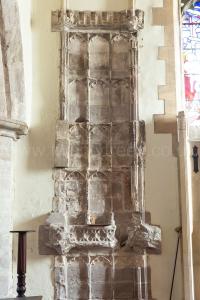
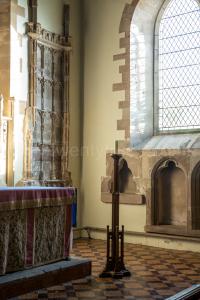
In 1998 the actor John Challis moved to Wigmore Abbey [Map].
In 2000 dendrochronological dating was undertaken what remains of Wigmore Abbey [Map]. Some woodwork in the undercroft has been dated to as early as 1213-1243. In the main building dates of 1482-1485, 1682 and 1729 were returned. The east wall contains a two light window which may date back to the thirteenth century. Some of the internal roof trusses would appear to be fourteenth century.
On 20 Oct 2016 John Challis published "Wigmore Abbey [Map]: The Treasure of Mortimer". Published by Wigmore Books Ltd: "John Challis recounts his arrival in Herefordshire and why he and his wife, Carol, decided to buy Wigmore Abbey. Arriving there in the late '90s, they threw themselves into the task of restoring the abbot's lodging – the only habitable part remaining of what had once been a great monastery."
Transactions of the Woolhope Club 1969 Page 413. The Anglo-Norman Chronicle Of Wigmore Abbey [Map] By J. C. Dickinson And P. T. Ricketts